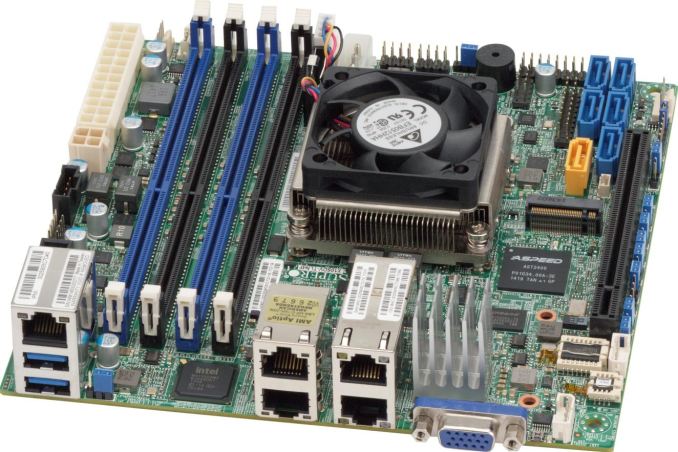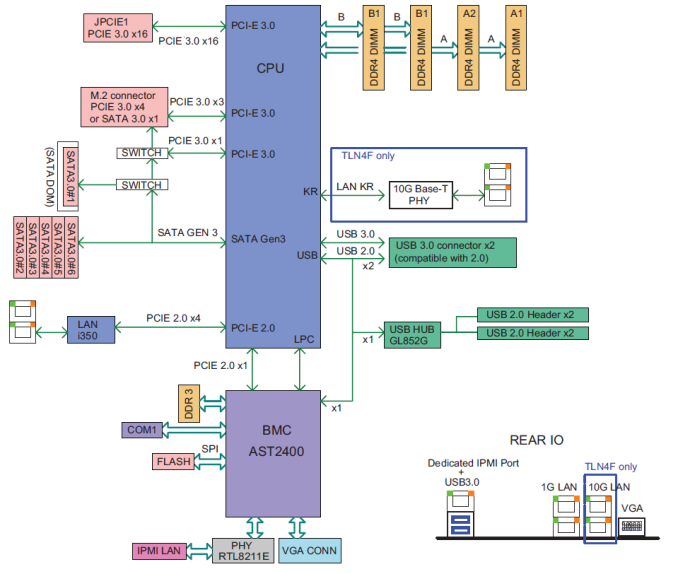The Intel Xeon D Review: Performance Per Watt Server SoC Champion?
by Johan De Gelas on June 23, 2015 8:35 AM EST- Posted in
- CPUs
- Intel
- Xeon-D
- Broadwell-DE
Inside the 5028D-TN4T
Inside the 5028D-TN4T, we find the mini-ITX X10SDV-TLN4F motherboard.
The logical layout of the board means that you need very few additional building blocks to make a server system with the Xeon D.
The X10SDV-TLN4F consists of Xeon D-1540, the BMC AST2400, a few PCIe switches and the Intel i350 gigabit chip. The AST2400 is a pretty potent BMC which can send 1920x1200 compressed pixels over a 1 Gbit Ethernet PHY. The 400MHz ARM926EJ embedded CPU was connected via a 16 bit interface to a 1 GB, 667 MHz Winbond Electronics W631GG6KB-15 DDR3-SDRAM. Impressive specs for a BMC.












90 Comments
View All Comments
extide - Tuesday, June 23, 2015 - link
That's ECC Registered, -- not sure if it will take that, but probably, although you dont need registered, or ECC.nils_ - Wednesday, June 24, 2015 - link
If you want transcoding, you might want to look at the Xeon E3 v4 series instead, which come with Iris Pro graphics. Should be a lot more efficient.bernstein - Thursday, June 25, 2015 - link
for using ECC UDIMMs, a cheaper option would be an i3 in a xeon e3 board.psurge - Tuesday, June 23, 2015 - link
Has Intel discussed their Xeon-D roadmap at all? I'm wondering in particular if 2x25GbE is coming, whether we can expect a SOC with higher clock-speed or more cores (at a higher TDP), and what the timeframe is for Skylake based cores.nils_ - Tuesday, June 23, 2015 - link
Is 25GbE even a standard? I've heard about 40GbE and even 56GbE (matching infiniband), but not 25.psurge - Tuesday, June 23, 2015 - link
It's supposed be a more cost effective speed upgrade to 10GbE than 40GbE (it uses a single 25Gb/s serdes lane, as used in 100GbE, vs 4 10Gb/s lanes), and IIRC is being pushed by large datacenter shops like Google and Microsoft. There's more info at http://25gethernet.org/. I'm not sure where things are in the standardization process.nils_ - Wednesday, June 24, 2015 - link
It also has an interesting property when it comes to using a breakout cable of sorts, you could connect 4 servers to 1 100GbE port (this is already possible with 40GbE which can be split into 4x10GbE).JohanAnandtech - Wednesday, June 24, 2015 - link
Considering that the Xeon D must find a home in low power high density servers, I think dual 10 Gbit will be standard for a while. Any idea what 25/40 Gbit PHY would consume? Those 10 Gbit PHYs already need 3 Watt in idle, probably around 6-8W at full speed. That is a large chunk of the power budget in a micro/scale out server.psurge - Wednesday, June 24, 2015 - link
No I don't, sorry. But, I thought SFP+ with SR optics (10GBASE-SR) was < 1W per port, and that SFP+ direct attach (10GBASE-CR) was not far behind? 10GBASE-T is a power hog...pjkenned - Tuesday, June 23, 2015 - link
Hey Johan - just re-read. A few quick thoughts:First off - great piece. You do awesome work. (This is Patrick @ ServeTheHome.com btw)
Second - one thing should probably be a bit clearer - you were not using a Xeon D-1540. It was a ES Broadwell-DE version at 2.0GHz. The shipping product has 100MHz higher clocks on both base and max turbo. I did see a 5% or so performance bump from the first ES version we tested to the shipping parts. The 2.0GHz parts are really close to shipping spec though. One both of my pre-release Xeon D and all of the post-release Xeon D systems was nearly identical.
Those will not change your conclusions but does make the actual Intel Xeon D-1540 a bit better than the one you tested. LMK if you want me to set aside some time on a full speed version on a Xeon D-1540 system for you.